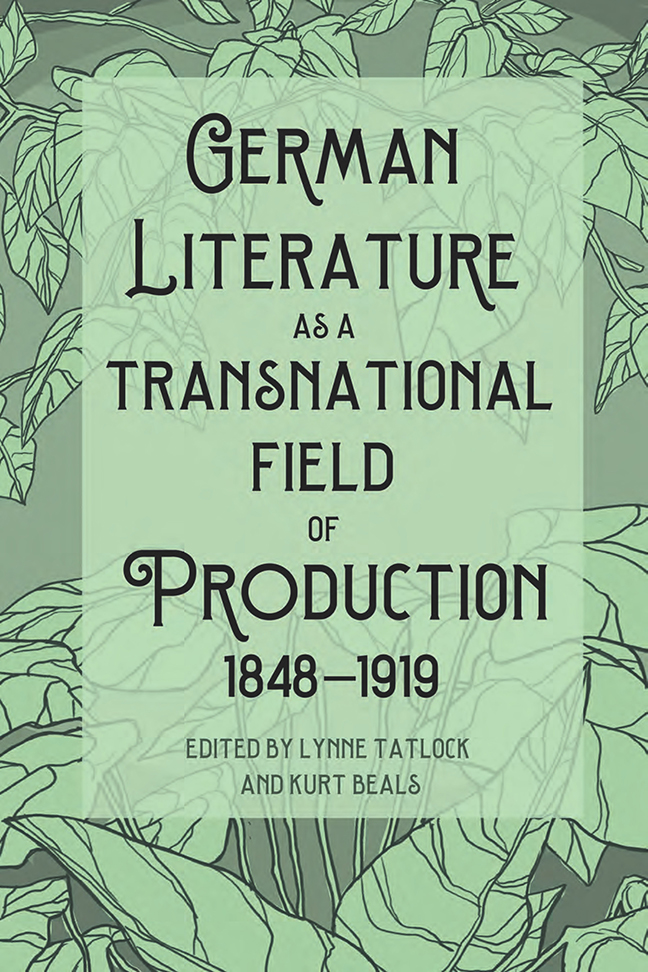Book contents
- Frontmatter
- Contents
- Acknowledgments
- Introduction: A Transnational Literary Field in the Age of Nationalism
- 1 The Passion of Johannes Scherr: Historiography as Trauma
- 2 Between Integration and Differentiation: On the Relationship between German and Austrian Literature in the Second Half of the Nineteenth Century
- 3 Reading Stifter in America
- 4 Travel Writing and Transnational Marketing: How Ida Pfeiffer brought the World to Austria and Beyond
- 5 Ernst Brausewetter's Meisternovellen Deutscher Frauen (1897–98): Gender, Genre, and (Inter)National Aspiration
- 6 Arbiter of Nation? The Strange Case of Hans Müller-Casenov's The Humour of Germany (1892/1893)
- 7 Visualizing the End: Nation, Empire, and Neo-Roman Mimesis in Keller and Fontane
- 8 Eurocentric Cosmopolitanism in Thomas Mann's Buddenbrooks
- 9 European Peace from a Transatlantic Perspective: Victor Hugo and Bertha von Suttner
- 10 Hermann Graf Keyserling and Gu Hongming’s Ethics of World Culture: Confucianism, Monarchism, and Anti-Colonialism
- 11 Constructing Symphonic Worlds: Gustav Mahler, Weltliteratur, and the Musical Program
- 12 The Garb of National Literature: Transnational Identities and the Early Twentieth-Century Schriftstreit
- 13 From European Symbolism to German Gesture: The International and Transnational Nationalism of Stefan George's Blätter für die Kunst
- 14 Canon Fire: Dada's Attack on National Literature
- Selected Bibliography
- Contributors
- Index
7 - Visualizing the End: Nation, Empire, and Neo-Roman Mimesis in Keller and Fontane
Published online by Cambridge University Press: 10 January 2024
- Frontmatter
- Contents
- Acknowledgments
- Introduction: A Transnational Literary Field in the Age of Nationalism
- 1 The Passion of Johannes Scherr: Historiography as Trauma
- 2 Between Integration and Differentiation: On the Relationship between German and Austrian Literature in the Second Half of the Nineteenth Century
- 3 Reading Stifter in America
- 4 Travel Writing and Transnational Marketing: How Ida Pfeiffer brought the World to Austria and Beyond
- 5 Ernst Brausewetter's Meisternovellen Deutscher Frauen (1897–98): Gender, Genre, and (Inter)National Aspiration
- 6 Arbiter of Nation? The Strange Case of Hans Müller-Casenov's The Humour of Germany (1892/1893)
- 7 Visualizing the End: Nation, Empire, and Neo-Roman Mimesis in Keller and Fontane
- 8 Eurocentric Cosmopolitanism in Thomas Mann's Buddenbrooks
- 9 European Peace from a Transatlantic Perspective: Victor Hugo and Bertha von Suttner
- 10 Hermann Graf Keyserling and Gu Hongming’s Ethics of World Culture: Confucianism, Monarchism, and Anti-Colonialism
- 11 Constructing Symphonic Worlds: Gustav Mahler, Weltliteratur, and the Musical Program
- 12 The Garb of National Literature: Transnational Identities and the Early Twentieth-Century Schriftstreit
- 13 From European Symbolism to German Gesture: The International and Transnational Nationalism of Stefan George's Blätter für die Kunst
- 14 Canon Fire: Dada's Attack on National Literature
- Selected Bibliography
- Contributors
- Index
Summary
“Confused Thoughts and Pictures”
Like much of Heinrich Heine's writing of the 1830s, his series of short articles on the Parisian Salon first published in the Morgenblatt für gebildete Stände in 1831 and subsequently in book form as Französische Maler (French Painters) offers reflections on the July Revolution and its aftermath. Heine uses the exhibit's juxtaposition of multiple paintings and the serial format of his journalistic reports as a double lens through which to consider the ends and beginnings of historical epochs in an age of revolution and its aftermath, a topic that will occupy us throughout this essay. In the concluding article, Heine discusses two paintings that the exhibit felicitously places side by side, and he seeks to recreate this visual juxtaposition on a textual level. The first, by Louis Robert, depicts agricultural workers outside of Rome. Heine finds in this tableau of reapers a representation of the lasting nature of the Roman people; the image presents a “Geschichte ohne Anfang und ohne Ende, die sich ewig wiederholt und so einfach ist wie das Meer, wie der Himmel, wie die Jahreszeiten” (history without beginning and without end that repeats itself eternally and is as simple as the sea, as the sky, as the seasons). This vaguely processional scene depicts festive dancing in rhythm with the seasonal harvest and evokes a classicizing shape of time based in the ceaseless repetition and constancy of Roman popular life, despite the fall of ancient Rome. The second painting, by Paul Delaroche, depicts Cromwell, the victorious representative of a new order, gazing down at the executed English king, Charles I.
- Type
- Chapter
- Information
- Publisher: Boydell & BrewerPrint publication year: 2023



